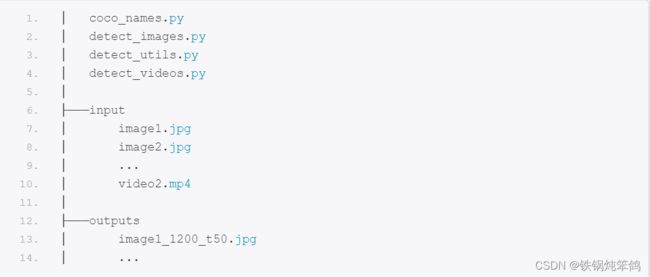pytorch retinanet目标检测
本文使用的是pytorch1.7.1,使用Pytorch提供的预训练模型,使用这个预训练模型,我们可以检测COCO数据集中超过80种物体。
RetinaNet的输入格式
输入图像的格式为[C, H, W],即(channels, height, and width),我们也需要提供一个batch size。batch size指一次处理多少张图像。所以输入图像格式为[N, C, H, W]。同时,图像的像素值要在0-1之间。
RetinaNet的输出格式
它输出一个列表包括一个字典,其包含结果张量。格式为List[Dict[Tensor]]。这个Dict包括以下keys:
boxes (FloatTensor[N, 4]):被预测的boxes是[x1, y1, x2, y2]格式
labels (Int64Tensor[N]):每个图片的预测标签
scores:(Tensor[N]):每个预测的得分
coco_names.py
COCO_INSTANCE_CATEGORY_NAMES = [
'__background__', 'person', 'bicycle', 'car', 'motorcycle', 'airplane', 'bus',
'train', 'truck', 'boat', 'traffic light', 'fire hydrant', 'N/A', 'stop sign',
'parking meter', 'bench', 'bird', 'cat', 'dog', 'horse', 'sheep', 'cow',
'elephant', 'bear', 'zebra', 'giraffe', 'N/A', 'backpack', 'umbrella', 'N/A', 'N/A',
'handbag', 'tie', 'suitcase', 'frisbee', 'skis', 'snowboard', 'sports ball',
'kite', 'baseball bat', 'baseball glove', 'skateboard', 'surfboard', 'tennis racket',
'bottle', 'N/A', 'wine glass', 'cup', 'fork', 'knife', 'spoon', 'bowl',
'banana', 'apple', 'sandwich', 'orange', 'broccoli', 'carrot', 'hot dog', 'pizza',
'donut', 'cake', 'chair', 'couch', 'potted plant', 'bed', 'N/A', 'dining table',
'N/A', 'N/A', 'toilet', 'N/A', 'tv', 'laptop', 'mouse', 'remote', 'keyboard', 'cell phone',
'microwave', 'oven', 'toaster', 'sink', 'refrigerator', 'N/A', 'book',
'clock', 'vase', 'scissors', 'teddy bear', 'hair drier', 'toothbrush'
]detect_utils.py
为了得到输出,我们需要一个简单的函数predict(),它接收4个输入参数,image、model、device、detection_threshold
import torchvision.transforms as transforms
import cv2
import numpy as np
import torch
from coco_names import COCO_INSTANCE_CATEGORY_NAMES as coco_names
#不同类别的框不同的颜色 为91个类生成随机的RGBtuple
COLORS = np.random.uniform(0, 255, size=(len(coco_names), 3))
# define the torchvision image transforms 把图片变成张量
transform = transforms.Compose([
transforms.ToTensor(),
])
def predict(image, model, device, detection_threshold):
# transform the image to tensor
image = transform(image).to(device)
image = image.unsqueeze(0) # add a batch dimension
with torch.no_grad():
outputs = model(image) # get the predictions on the image
# get all the scores
scores = list(outputs[0]['scores'].detach().cpu().numpy())
# index of those scores which are above a certain threshold
thresholded_preds_inidices = [scores.index(i) for i in scores if i > detection_threshold]
# get all the predicted bounding boxes
bboxes = outputs[0]['boxes'].detach().cpu().numpy()
# get boxes above the threshold score
boxes = bboxes[np.array(scores) >= detection_threshold].astype(np.int32)
# get all the predicited class names
labels = outputs[0]['labels'].cpu().numpy()
pred_classes = [coco_names[labels[i]] for i in thresholded_preds_inidices]
return boxes, pred_classes
def draw_boxes(boxes, classes, image):
for i, box in enumerate(boxes):
color = COLORS[coco_names.index(classes[i])]
cv2.rectangle(
image,
(int(box[0]), int(box[1])),
(int(box[2]), int(box[3])),
color, 2
)
cv2.putText(image, classes[i], (int(box[0]), int(box[1]-5)),
cv2.FONT_HERSHEY_SIMPLEX, 0.8, color, 2,
lineType=cv2.LINE_AA)
return image
def predict(image, model, device, detection_threshold):
首先把图像传入RetinaNet模型中,并得到输出
with torch.no_grad():
outputs = model(image)
得到输出字典中所有的得分
scores = list(outputs[0]['scores'].detach().cpu().numpy())
提取大于threshold的对应的索引
thresholded_preds_inidices = [scores.index(i) for i in scores if i > detection_threshold]
提取输出字典中的所有候选框
bboxes = outputs[0]['boxes'].detach().cpu().numpy()
过滤出大于threshold的候选框
boxes = bboxes[np.array(scores) >= detection_threshold].astype(np.int32)
def draw_boxes(boxes, classes, image):
boxes是前面过滤提取出来的候选框
classes是分类
image是在上面画框和标上分类名
detect_images.py
import torchvision
import torch
import argparse
import cv2
import detect_utils
import numpy as np
from PIL import Image
# construct the argument parser
parser = argparse.ArgumentParser()
parser.add_argument('-i', '--input', help='path to input image/video')
parser.add_argument('-m', '--min-size', dest='min_size', default=800,
help='minimum input size for the RetinaNet network')
parser.add_argument('-t', '--threshold', default=0.6, type=float,
help='minimum confidence score for detection')
args = vars(parser.parse_args())
print('USING:')
print(f"Minimum image size: {args['min_size']}")
print(f"Confidence threshold: {args['threshold']}")
# download or load the model from disk
model = torchvision.models.detection.retinanet_resnet50_fpn(pretrained=True,
min_size=args['min_size'])
device = torch.device('cuda' if torch.cuda.is_available() else 'cpu')
# load the model onto the computation device
model.eval().to(device)
image = Image.open(args['input']).convert('RGB')
# a NumPy copy for OpenCV functions
image_array = np.array(image)
# convert to OpenCV BGR color format
image_array = cv2.cvtColor(image_array, cv2.COLOR_RGB2BGR)
# get the bounding boxes and class labels
boxes, classes = detect_utils.predict(image, model, device, args['threshold'])
# get the final image
result = detect_utils.draw_boxes(boxes, classes, image_array)
cv2.imshow('Image', result)
cv2.waitKey(0)
save_name = f"{args['input'].split('/')[-1].split('.')[0]}_{args['min_size']}_t{int(args['threshold']*100)}"
cv2.imwrite(f"outputs/{save_name}.jpg", result)https://download.pytorch.org/whl/torch_stable.html

